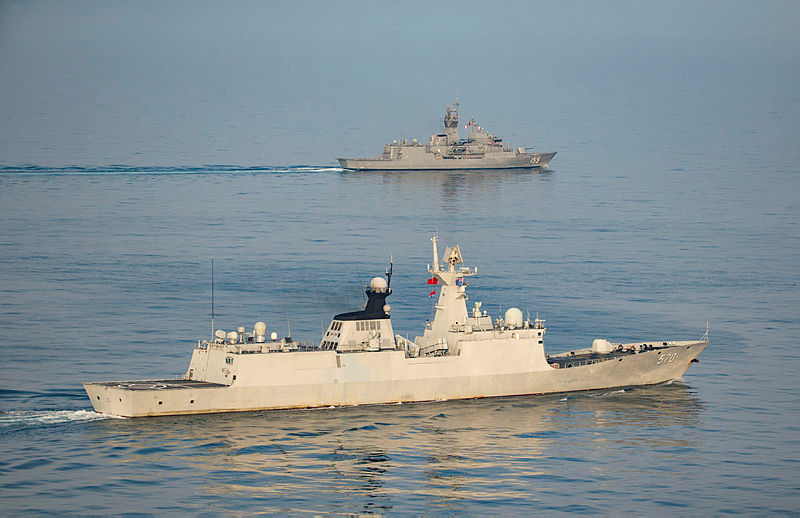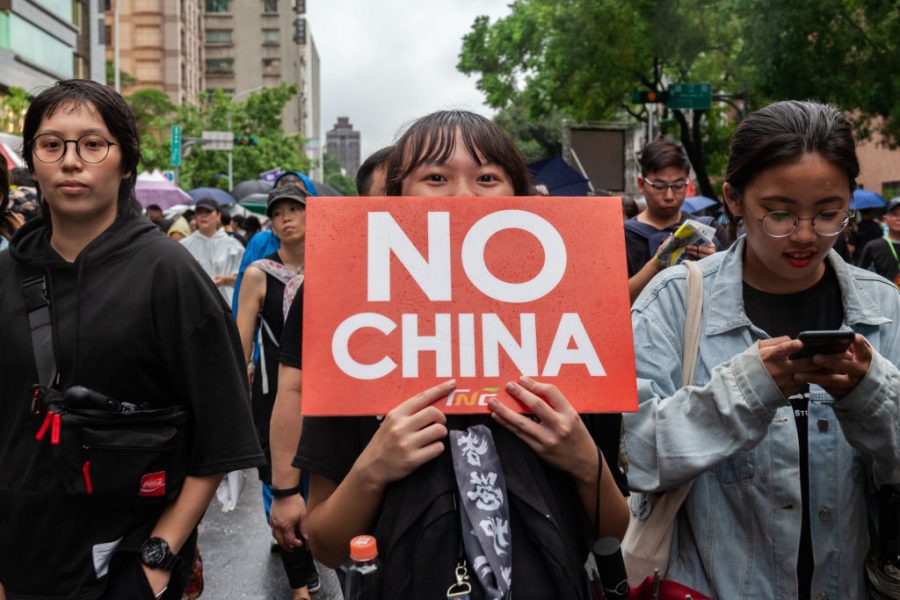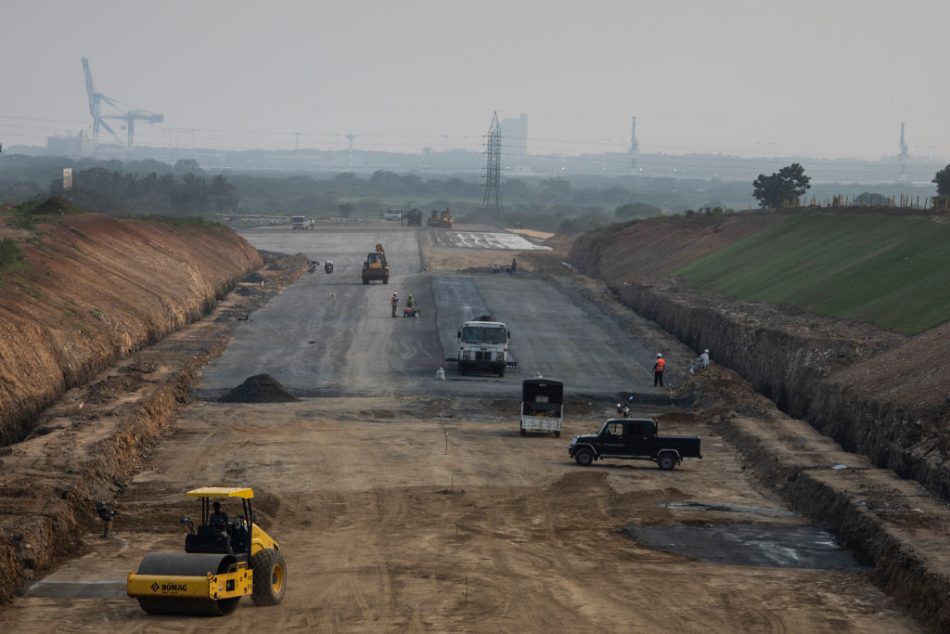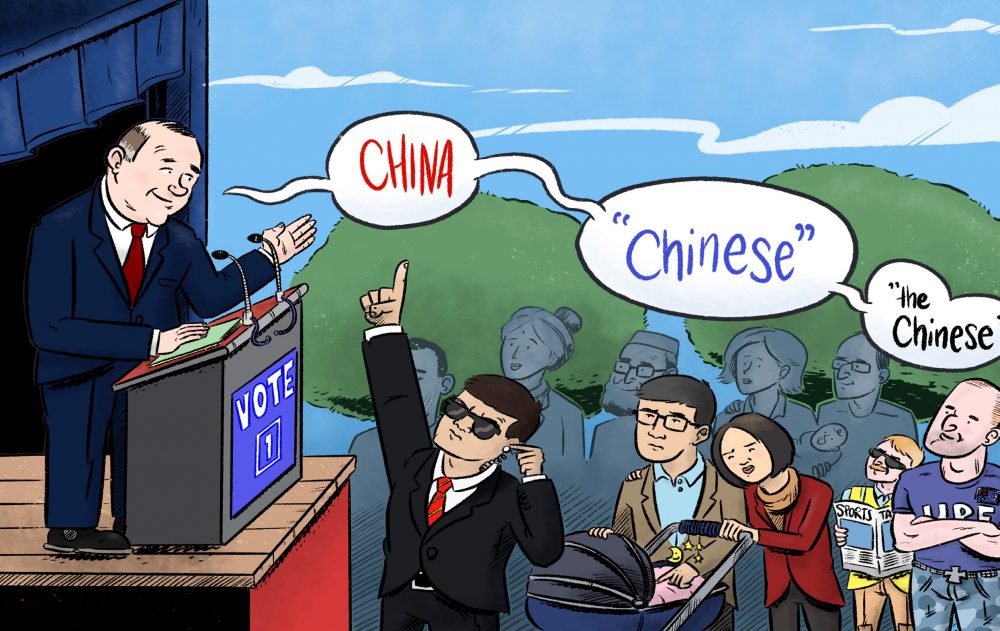
When the People’s Liberation Army Navy flotilla berthed in Sydney in front of an adoring crowd of Chinese Australians, you can be sure that the timing and look of the event had been planned in every detail.
Right down to the professionally painted welcome signs, nothing is left to chance in the way the Chinese Communist Party commands the PLA Navy. The ships did not arrive off Sydney’s Heads by accident and the party would clearly get the diversionary value of making China’s biggest naval port call to Australia on the anniversary of the Tiananmen Square massacre.
The visit reinforces the CCP’s domestic message that China is now a global military power. As the more strident of the party’s English-language newspapers, the Global Times, wrote recently: ‘A strong Chinese navy is the guarantee for peace and stability of the South China Sea and even the whole world.’
When the Australian navy make port visits, the intent is to promote goodwill: ships are open for inspection and visitors are hosted by smiling sailors. By contrast, and as the Australian recorded, the PLA vessels were guarded by heavily armed crew looking more like special forces soldiers on an operation. The ships were off limits to all but the most trusted local backers, with the usual blackout applied to Australian media.
Beijing’s message to us is about projecting power, turning the spotlight away from a time when the PLA was mobilised to kill thousands of Chinese students. To quote the Global Times again: ‘It reminds us Chinese of the necessity and urgency to strengthen Chinese naval forces … We Chinese only need to keep calm. It is certain that China will hold more initiatives in its offshore area.’
That was the party’s propaganda purpose behind the visit, but Australians should be asking what our objectives were in hosting it. Who in Canberra thought it was a good idea to allow the ships to arrive on the Tiananmen anniversary? One version is that an arrival date hadn’t been agreed and the ships just turned up.
Whatever the reality, the PLA Navy presence pressured our politicians into muting their comments about the massacre. In Honiara, Scott Morrison would not answer questions on the anniversary and said the foreign minister would express the government’s views. A 47-word media release from Marise Payne timidly noted the anniversary without saying who ordered the guns to be turned on the students.
The statement expressed the gentlest of concerns about ‘continuing constraints on freedom of association, expression and political participation in China’ as though the problem here is a bit of constitutional trimming rather than the behaviour of an authoritarian dictatorship.
Australia’s willingness to look the other way in the face of an increasingly assertive China has been evident since Xi Jinping came to power in 2012. At one level it’s understandable. During the years of China’s so-called ‘peaceful rise’ it seemed possible that, while the Chinese economy grew, we could get rich without compromising our national security interests.
That time has passed. Australian governments now must handle a more complicated relationship with Beijing, where our fundamental differences of national interest cannot be papered over. Our reflex instinct to tolerate Beijing’s bad behaviour will damage us. If China’s leaders conclude that Australia will tolerate any slight, no one should be surprised if their ill-disguised disregard of us continues.
Many times, Australian governments have chosen to overlook Chinese hostile and damaging behaviour, based on public service advice that turning the other cheek will save our economy from Beijing’s ‘punishment’.
In the cyber realm, China is a sophisticated and persistent aggressor seeking to steal intellectual property from Australia’s universities and businesses while gathering intelligence on government and political secrets.
Trying to persuade Beijing to limit this wholesale cyber theft, Australia held its first (and, so far, only) ‘Australia–China High-Level Security Dialogue’ in April 2017. In a joint statement, both countries ‘agreed not to conduct or support cyber-enabled theft of intellectual property, trade secrets or confidential business information with the intent of obtaining competitive advantage’.
The senior Chinese official at the meeting, Meng Jianzhu, was told how much Australian agencies knew about Chinese cyber hacking in the hope that ‘naming and shaming’ might improve behaviour.
Of course, the spying has only gotten worse. China has been outed as comprehensively infiltrating the Australian National University’s IT network. There have been public revelations about ‘sophisticated state actors’ using cyber means to attack the Australian parliament, the headquarters of the Liberal, Labor and National parties and, just this week, the ANU for a second time.
The ‘sophisticated state actor’ is China’s Ministry of State Security. The Australian government won’t say that because of the fear of Beijing’s punishment.
A second example is China’s annexation of the South China Sea and construction of three large airbases on reclaimed land. In 2016, our government, lacking confidence in the Obama administration’s willingness to oppose China’s illegal annexation, decided not to conduct freedom-of-navigation operations near any ‘contested feature’.
Julie Bishop said in March 2018, ‘What we won’t do is unilaterally provoke an increase in tensions’ by sailing too close to the islands. Astonishingly, this reversed the onus of responsibility for destabilising the region.
If the aim was to prompt an improvement in Chinese behaviour, Australia’s softly, softly approach has achieved the opposite. The Global Times editorialised in 2015 that ‘it would be a shame if one day a plane fell from the sky and it happened to be Australian’, and only a few days ago an Australian helicopter operating in the South China Sea was ‘lased’ from a so-called Chinese fishing vessel.
Lasing is a hostile act designed to damage pilots’ optic nerves. The Australian Defence Force chose not to publicly reveal the incident, saying instead that its Chinese counterparts ‘were friendly, they were professional and said g’day’.
So, Chinese paramilitary units on one day commit a hostile act against an Australian helicopter in international airspace and, far from objecting to such unacceptable and highly risky behaviour, Australia’s response is to welcome the PLA Navy into Sydney Harbour.
Only a few days after Morrison revealed that Australia’s political parties had been hacked by a sophisticated state actor, our Department of Foreign Affairs and Trade announced that substantially increased funding would be provided for ‘a new and innovative National Foundation for Australia–China Relations’. A breathless media release claimed that, ‘This new initiative reflects the Australian Government’s commitment to a constructive relationship with China, founded on shared interests, mutual benefit and mutual respect.’
‘Mutual respect’? Is DFAT serious?
But the list of slights and Australian non-responses goes on. In January, an Australian-Chinese national, Yang Hengjun, was detained without charge by Chinese state security police. Days later, a five-line Foreign Affairs statement said that officials were ‘seeking to clarify the nature of this detention’, but that’s the limit of what was said publicly. Contrast that with the loud ministerial interventions and prime ministerial photo opportunities for Hakeem al-Araibi, the Australian footballer detained by Thai authorities.
And finally there’s the Chinese company Huawei. Last August, the Australian government took the right decision to exclude from the 5G network any companies ‘who are likely to be subject to extrajudicial directions from a foreign government that conflict with Australian law’.
That decision, which has received bipartisan support, effectively excludes Huawei from Australia’s future 5G network. Huawei’s response was to claim that the decision was ‘politically motivated, not the result of a fact-based, transparent, or equitable decision-making process.’
In May, Huawei invited some Australian organisations (not ASPI) on an all-expenses-paid visit to China. Huawei’s chairman, John Lord, explains: ‘As your organisation is often called on by the media and government to comment or provide advice about the Australia–China relationship, Huawei wishes to invite you or a colleague to join an Australian Think Tank study tour to refresh or broaden your understanding of our largest trading partner.’
The visit proposes extensive briefings with Australian diplomatic staff in Guangdong, Shanghai and Beijing. So, here we have one part of government, Foreign Affairs, supporting the efforts of Huawei to influence Australian institutions ‘that comment or provide advice’ to other parts of government about policy decisions already taken.
The Morrison government must get its thinking on China into coherent shape. Silence in the face of bad behaviour from the PLA or intelligence agencies only encourages more bad behaviour. Naive attempts to curry favour by funding activities in the name of ‘mutual benefit and mutual respect’ fool no one.
Having considered every other option first, ultimately our government will need to behave a bit more like China—by strongly promoting our national interests, speaking plainly in defence of our core values, and explaining our strategic priorities to the Australian public.
In the unlikely event that Beijing does respond by punishing an Australian government, our leaders will have the consolation of having behaved according to the values that we claim inform our foreign policy. That won’t be unpopular domestically.







